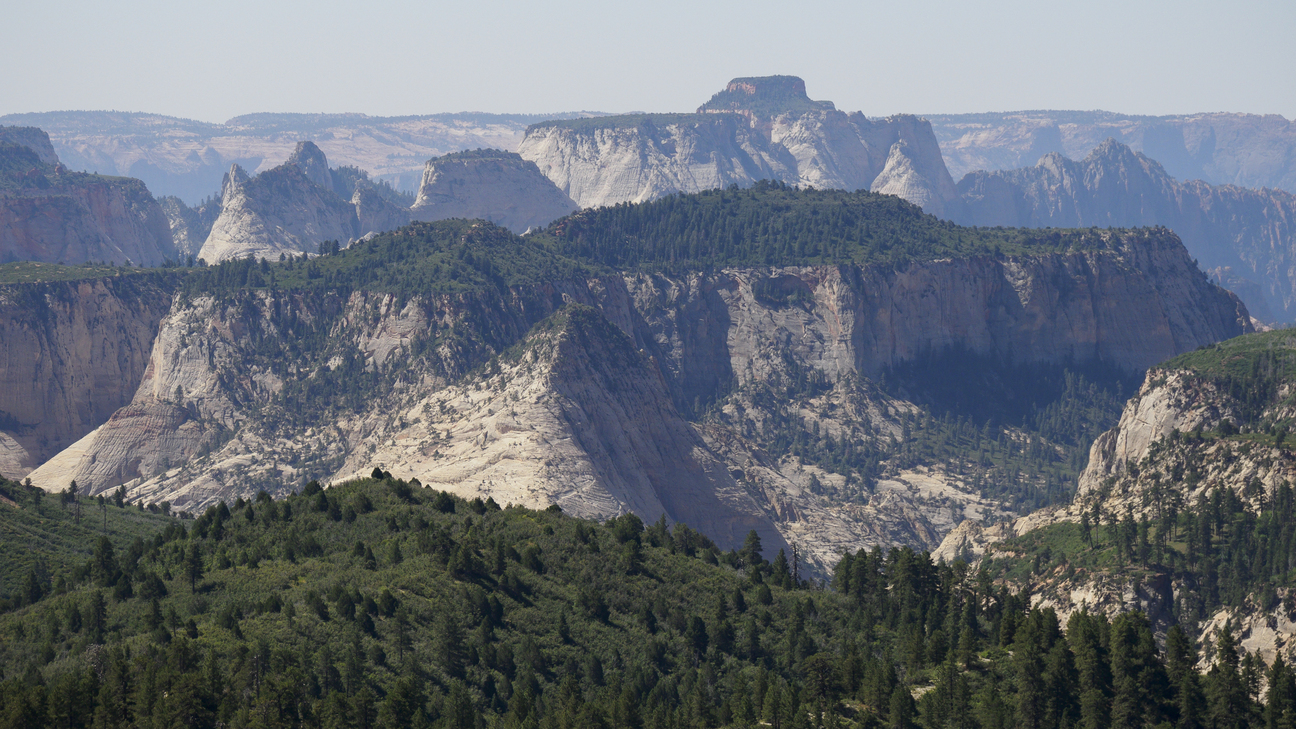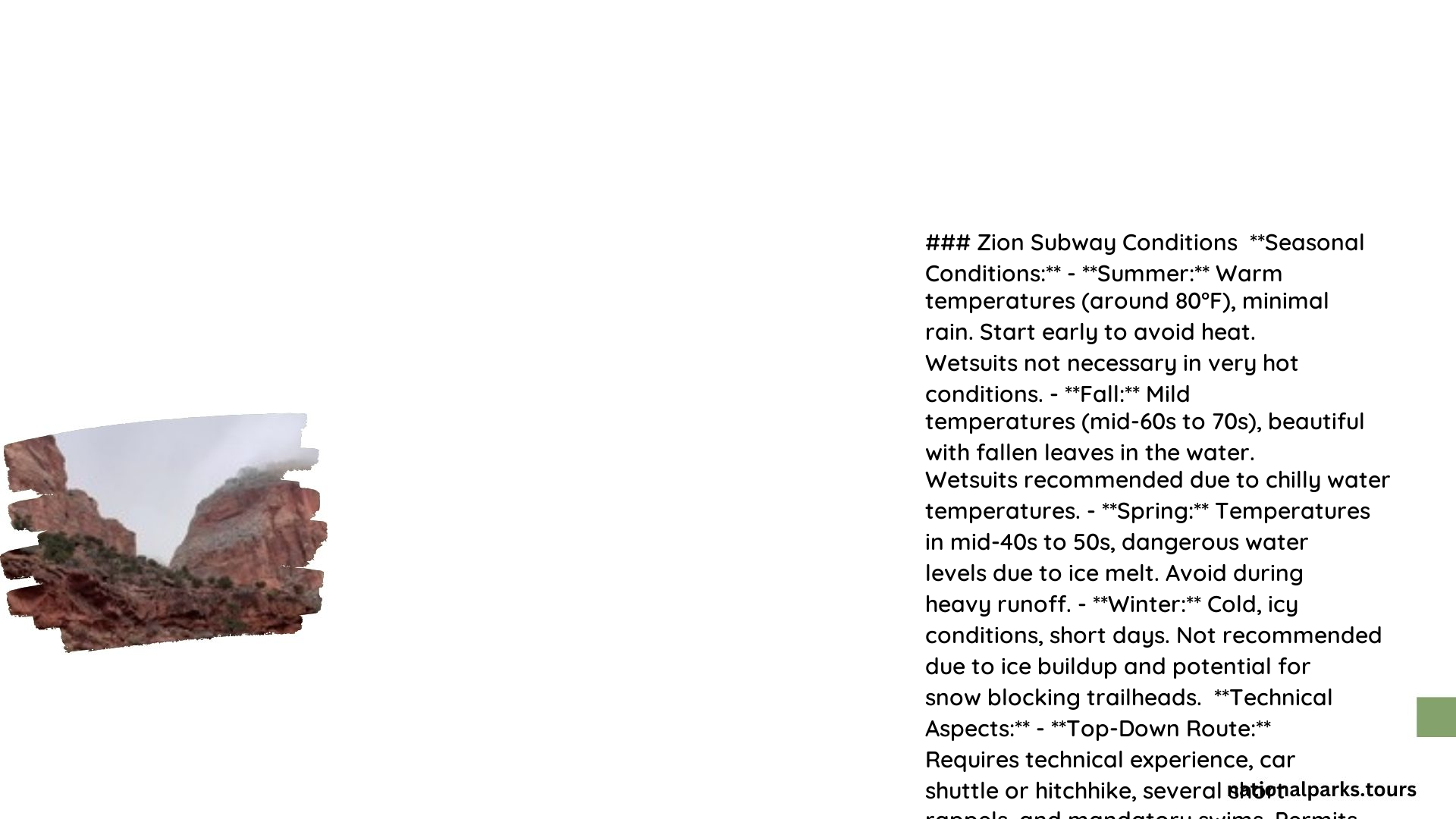The Zion Subway trail is a challenging 9.5-mile round trip hike in Zion National Park. It involves navigating through the Left Fork of North Creek, requiring wading, swimming, and scrambling. Water levels typically range from 1-3 feet, with some deeper pools. The trail is highly demanding, rated 8/10 in difficulty, and unsuitable for beginners. Weather significantly impacts conditions, with flash floods posing a major risk. Permits are required, and proper gear is essential for safety.
What is the Zion Subway Trail?

The Zion Subway trail is a unique and challenging hiking experience within Zion National Park. This semi-technical canyoneering route offers adventurers a chance to explore one of the most picturesque and geologically fascinating areas of the park. The trail gets its name from a section of the canyon that resembles a subway tunnel, carved out by centuries of water erosion.
Key features of the Zion Subway trail include:
- Length: 9.5 miles round trip
- Classification: Semi-technical canyoneering route
- Main path: Left Fork of North Creek
- Terrain: Varied, including creek beds, boulder fields, and narrow canyons
What are the Current Water Conditions in the Subway?

Water conditions in the Zion Subway can vary significantly based on recent weather patterns and seasonal changes. As of the latest reports:
- Average water depth: 1 to 3 feet
- Deeper pools: Some areas require swimming
- Chest-deep sections: Possible, especially after recent flash floods
- Water temperature: Generally cold, even in summer months
It’s crucial to note that water conditions can change rapidly due to weather events. Always check with park rangers for the most up-to-date information before embarking on your hike.
How Difficult is the Zion Subway Trail?
The Zion Subway trail is renowned for its challenging nature. Here’s a breakdown of its difficulty:
- Overall difficulty rating: 8/10
- Technical skills required:
- Off-trail hiking experience
- Scrambling over boulders
- Navigating through cold water
- Physical demands:
- Endurance for a 9.5-mile round trip
- Strength for climbing and scrambling
- Ability to swim in some sections
- Mental challenges:
- Route finding, especially in the top-down approach
- Dealing with potential exposure to heights
- Managing cold water immersion
The top-down route is particularly demanding, involving rappelling and extensive route finding. This option should only be attempted by experienced canyoneers.
What Weather Factors Affect the Subway Trail?
Weather plays a crucial role in the conditions and safety of the Zion Subway trail. Key weather factors to consider include:
| Weather Factor | Impact on Trail |
|---|---|
| Flash Floods | Major risk, can dramatically increase water levels and danger |
| Recent Rainfall | Can make rocks slippery and increase water flow |
| High Temperatures | Can make the ascent out of the canyon challenging, especially in summer |
| Thunderstorms | Increase risk of flash floods and lightning strikes |
Always check the weather forecast before your hike and be prepared to cancel or postpone if conditions are unfavorable.
What Safety Guidelines Should Hikers Follow?
Safety is paramount when tackling the Zion Subway trail. Here are essential guidelines to follow:
- Obtain necessary permits:
- Required for both top-down and bottom-up routes
-
Acquired through a lottery system
-
Bring appropriate gear:
- Sturdy hiking shoes with good tread
- Ropes and harnesses (for top-down route)
- Wetsuits or drysuits (recommended for cold water sections)
- At least 3 liters of water per person
-
Hiking poles for stability
-
Hike with experienced companions:
- Group support is crucial for safety
-
Share knowledge and skills
-
Be aware of environmental hazards:
- Slippery rock surfaces, especially on the red ledge
- Potential for sudden weather changes
-
Challenging 400-foot ascent at the end of the hike
-
Stay informed:
- Check current weather forecasts
- Consult park ranger advisories before starting the hike
How Do Recent Weather Events Affect Trail Conditions?
Recent weather events can significantly impact the conditions of the Zion Subway trail. As of the latest reports:
- Flash floods have occurred, potentially altering water levels and trail conditions
- Debris may have been deposited along the trail, creating new obstacles
- Water clarity might be affected, making it harder to judge depth in some areas
- Rock surfaces may be more slippery than usual due to increased moisture
It’s essential to:
1. Check current weather forecasts before your hike
2. Consult with park rangers about recent weather impacts
3. Be prepared to adjust your plans based on current conditions
What are the Specific Challenges of the Top-Down Route?
The top-down route of the Zion Subway trail presents unique challenges:
- Technical requirements:
- Rappelling skills
- Use of ropes and harnesses
-
Advanced route finding abilities
-
Physical demands:
- More strenuous than the bottom-up route
-
Requires greater upper body strength for down-climbing
-
Equipment needs:
- Specialized canyoneering gear
-
Proper footwear for wet and dry conditions
-
Time management:
- Typically takes longer than the bottom-up route
-
Requires careful planning to avoid being caught in the canyon after dark
-
Environmental considerations:
- Greater exposure to cold water for longer periods
- Increased risk due to more technical sections
This route should only be attempted by those with significant canyoneering experience or under the guidance of a qualified instructor.
How Does the Bottom-Up Route Differ from the Top-Down Approach?
The bottom-up route offers a different experience compared to the top-down approach:
- Accessibility:
- Generally more accessible for hikers with less technical experience
-
Does not require rappelling skills
-
Length and duration:
- Shorter overall distance
-
Can be completed in less time than the top-down route
-
Scenic highlights:
- Allows hikers to see the most iconic parts of the Subway
-
Includes the famous “subway” section of the canyon
-
Physical demands:
- Still challenging, but less technically demanding
-
Requires good hiking fitness and some scrambling ability
-
Water exposure:
- Less time spent in cold water compared to top-down route
- Still involves wading and possible swimming in some sections
While easier than the top-down route, the bottom-up approach is still a strenuous hike that requires proper preparation and respect for the environment.
What are the Best Times of Year to Hike the Subway?
The optimal time to hike the Zion Subway depends on various factors:
- Spring (April to May):
- Moderate temperatures
- Higher water levels from snowmelt
-
Wildflowers in bloom
-
Summer (June to August):
- Warmest temperatures, but can be extremely hot
- Lower water levels, making some sections easier
-
Busiest season, more difficult to obtain permits
-
Fall (September to October):
- Pleasant temperatures
- Lower water levels
-
Beautiful fall colors in the surrounding landscape
-
Winter (November to March):
- Cold temperatures, requiring additional gear
- Possible ice and snow on the trail
- Least crowded, but most challenging conditions
Consider your skill level, comfort with cold water, and desired experience when choosing the best time for your hike.
By understanding these various aspects of the Zion Subway conditions, hikers can better prepare for this challenging and rewarding adventure. Always prioritize safety, respect the natural environment, and be prepared to adjust your plans based on current conditions.
References:
1. How to Hike the Subway in Zion, Top-Down (Canyoneering Route)
2. The Subway, Utah – 3,376 Reviews, Map | AllTrails
3. The Subway Hiking Trail in Zion National Park | Utah.com
